Why the United States Should Invest in Renewable Energy
- Zane Johnson
- Apr 11, 2022
- 6 min read
In Northern China, 4,000 years ago, a person unearthed a peculiar rock (“The Story of Fossil Fuels, Part 1: Coal”). This rock was the first discovery of fossil fuel: coal. Since then, fossil fuels have been the world's main source of energy making up 84% of energy consumption (Rapier). However, the rise of renewable energy sources has lowered the need for the utilization of fossil fuels. In fact, many countries have already started using renewable energy sources. For example, Costa Rica uses hydropower, geothermal, wind, and solar power to produce 95% of its electricity (Climate Council). The reason for this switch is because of the environmental and economic benefits that renewable energy sources provide. These benefits have also caused many people in the United States to want the country to switch to renewable energy. Many oppose renewable sources because they produce waste and take away fossil fuel-related jobs. However, the United States should invest in renewable energy because of its location versatility, ability to reduce air pollution, capability to turn waste into energy, lower costs, and job variety.
A primary reason why the United States should invest in renewable energy is because it reduces the number of pollutants in the air. Even though fossil fuels create more energy, they also create more air emissions. Fossil fuels do this by releasing greenhouse gases. According to the Environmental Protection Agency, Greenhouse gases such as carbon dioxide cause "trap heat in the atmosphere" (“Overview of Greenhouse Gases | US EPA”). As reported by the U.S. Energy Information Administration, the United States alone released 5.1 billion metric tons of carbon dioxide into the atmosphere in 2019. These emissions cause air pollution which kills up to 7 million people annually (Wood). This makes air pollution a leading factor in death in the world (Ritchie and Roser) (Fig. 1). This was measured using a global disease burden which considers years of life lost and years lived with poor health (Ritchie and Roser).
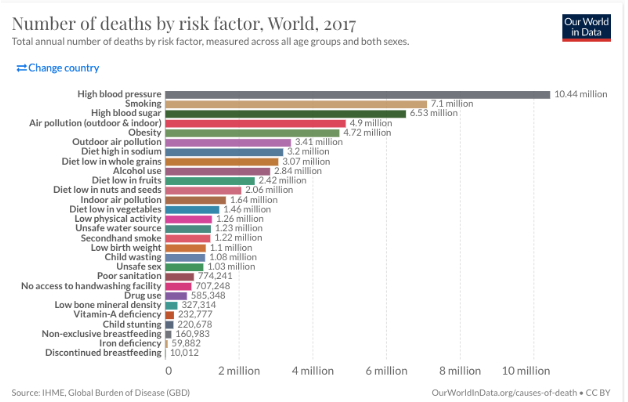
Fig. 1. Chart of deaths by risk factor from: Ritchie, Hannah, and Max Roser. “Air Pollution.” Our World in Data, 17 Apr. 2017, ourworldindata.org/air-pollution. Accessed 15 Dec. 2021.
Fortunately, renewable energy reduces the number of pollutants in the atmosphere because it emits little to no emissions (“Benefits”). The U.S. Department of Energy did a study that measured the amount of emissions vehicles released based on their energy source. According to the U.S. Department of Energy, gasoline-based cars release around 11,435 pounds of carbon dioxide, while all-electric cars release 3,783 pounds of carbon dioxide (“Alternative Fuels Data Center: Emissions from Hybrid and Plug-in Electric Vehicles”).
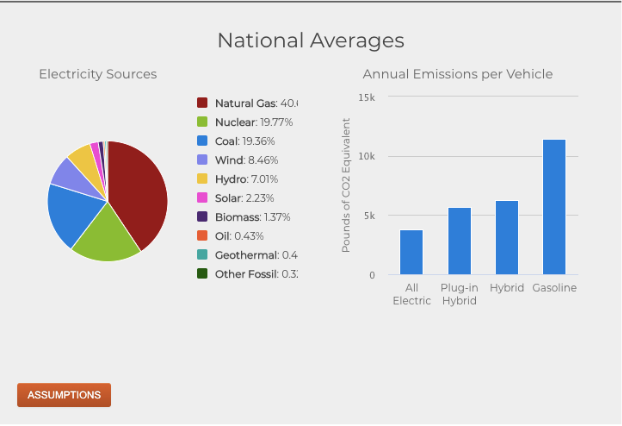
Fig. 2. Charts of natural averages of electricity and emission sources from: “Alternative Fuels Data Center: Emissions from Hybrid and Plug-in Electric Vehicles.” Energy.gov, 2021, afdc.energy.gov/vehicles/electric_emissions.html. Accessed 15 Dec. 2021.
Furthermore, renewable energy has location versatility. This means that it can be used in a variety of places. Many argue that renewable energy can only be used in specific locations. Fortunately, there are five main types of renewable energy: solar, wind, biomass, hydropower, and geothermal. Solar power uses photovoltaic (PV) cells. The cells absorb sunlight and turn to convert the sunlight into electrons. The electrons are then used to create energy (Wiliams). Wind power uses turbines to harness the wind to generate electricity (Williams). Biomass burns organic material such as crops to create more forms of energy (Williams). Hydropower uses water and turbines to form electricity (Williams). Geothermal uses heat from the earth to power and heat buildings (Williams). Having a wide variety of renewable energy sources means that each place can choose a source based on its climate, conditions, and landscape. For example, having wind turbines in Mississippi would be inefficient because the state does not have enough wind to create a reliable energy source. However, the United States’ Midwest will provide efficient and reliable energy because of the steady winds (National Geographic Society).
Even though renewable energy offers many advantages, a downside to renewable energy is that it produces waste. In developing countries, solar panels are projected to produce 78 million metric tons of waste (“The Good, Bad, and Ugly about Renewable Energy in Developing Countries”). The types of waste include cadmium, copper, lead, lithium, and silicon which are all harmful to human health and the environment (“The Good, Bad, and Ugly about Renewable Energy in Developing Countries”). In addition to the effect on health and the environment, this waste takes away valuable materials from the economy (“The Good, Bad, and Ugly about Renewable Energy in Developing Countries”). However, this waste can be used to make electricity by using waste-to-energy plants (“Waste-To-Energy (MSW) - U.S. Energy Information Administration (EIA)”). According to the U.S. Energy Information Administration, waste-to-energy plants take waste from energy-waste materials and burn it to produce energy. Many countries, such as Japan, use this method to reduce the size of landfills and add more valuable material to improve the economy (“Waste-To-Energy (MSW) - U.S. Energy Information Administration (EIA)”). By implementing Waste-to-Energy plants, the United States can reduce the amount of waste in landfills and create a new source of energy.
Another benefit of renewable energy is its lower costs. Even though they are readily available, the costs of fossil fuels have been increasing rapidly. In the year 2021, oil costs around 3.391 dollars per gallon (“U.S. No. 2 Heating Oil Residential Price (Dollars per Gallon)”).
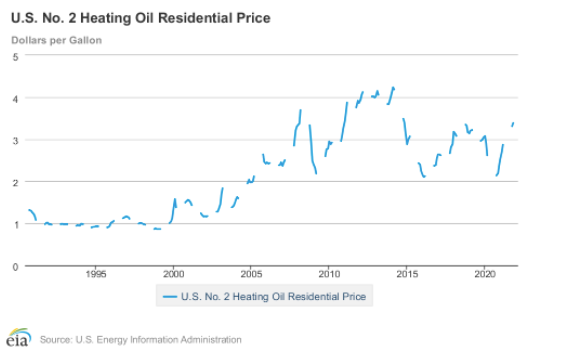
Fig. 3. Graph of oil prices every year from: “U.S. No. 2 Heating Oil Residential Price (Dollars per Gallon).” Eia.gov, 2011, www.eia.gov/dnav/pet/hist/LeafHandler.ashx?n=PET&s=M_EPD2F_PRS_NUS_DPG&f=M. Accessed 15 Dec. 2021.
The costs of renewable energy have been decreasing to the point where some renewable energy sources are more financially beneficial than fossil fuels (Timmons et al.). In fact, renewables are starting to become more affordable than the cheapest coal (“Renewables Increasingly Beat Even Cheapest Coal Competitors on Cost”). To be competitive with fossil fuels, they have to fall in the wholesale electricity price or the price of fossil fuel power in the graph. Since hydropower and biomass fall in the wholesale electricity price section on the graph, they are competitive with fossil fuels.

Even though solar and wind power are not in this region, the prices for both forms of energy are decreasing every year. According to the International Renewable Energy Agence (IRENA), costs of solar power lowered by 16%, and costs of wind power lowered by 9% (Ambrose).
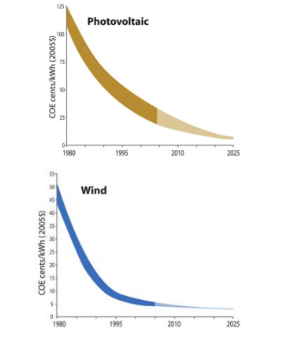
Fig. 5 Graph of decreasing solar and wind costs from: Timmons, David, et al. The Economics of Renewable Energy a GDAE Teaching Module on Social and Environmental Issues in Economics. 2014.
Another opposition is that renewable energy will take away jobs in the fossil fuel industry. In areas where fossil fuel employment is very high, losing jobs will severely damage the economy (Adie Tomer et al.).

Fig. 6 Map of fossil fuel employment from: Adie Tomer, et al. “How Renewable Energy Jobs Can Uplift Fossil Fuel Communities and Remake Climate Politics.” Brookings, Brookings, 19 Feb. 2021, www.brookings.edu/research/how-renewable-energy-jobs-can-uplift-fossil-fuel-communities-and-remake-climate-politics/. Accessed 15 Dec. 2021.
However, renewable energy will provide a surplus and a variety of new jobs. In 2015, green energy employment grew by 5%. This means that the renewable industry introduced 8.1 million jobs (Smith). During this time, oil lost 350,000 jobs because of a slump in oil prices.
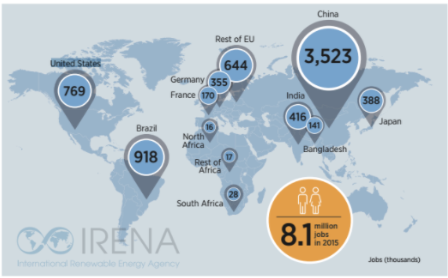
Fig. 7 jobs in renewable energy from: Smith, Heather. “There Are More Jobs in Renewable Energy than in Oil, Gas, and Coal Combined.” Grist, Grist, 31 May 2016, grist.org/business-technology/there-are-more-jobs-in-renewable-energy-than-in-oil-gas-and-coal-combined/. Accessed 15 Dec. 2021
Switching to renewable energy can eliminate 4 to 7 million deaths and reverse the effects of global warming (Wood). By accessing numerous environmental and economic benefits, the United States should invest in renewable energy. Renewable energy not only reduces waste and air emissions but is also cost-efficient and versatile.. In the words of Martin Heinrich, “When it comes to renewable energy, there's no reason America should settle for second best.”
Works Cited
U.S. No. 2 Heating Oil Residential Price (Dollars per Gallon), www.eia.gov/dnav/pet/hist/LeafHandler.ashx?n=PET&s=M_EPD2F_PRS_NUS_DPG&f=M.
Climate Council / 13 January 2019. “11 Countries Leading the Charge on Renewable Energy.” Climate Council, 3 Feb. 2021, www.climatecouncil.org.au/11-countries-leading-the-charge-on-renewable-energy/.
“Emissions from Hybrid and Plug-In Electric Vehicles.” Alternative Fuels Data Center: Emissions from Hybrid and Plug-In Electric Vehicles, afdc.energy.gov/vehicles/electric_emissions.html.
“How Much Carbon Dioxide Does the United States and the World Emit Each Year from Energy Sources?” How Much Carbon Dioxide Does the United States and the World Emit Each Year from Energy Sources? | U.S. Geological Survey, www.usgs.gov/faqs/how-much-carbon-dioxide-does-united-states-and-world-emit-each-year-energy-sources.
“Most New Wind and Solar Projects Will Be Cheaper than Coal, Report Finds.” The Guardian, Guardian News and Media, 23 June 2021, www.theguardian.com/environment/2021/jun/23/most-new-wind-solar-projects-cheaper-than-coal-report.
National Geographic Society. “Renewable Energy.” National Geographic Society, 15 Feb. 2013, www.nationalgeographic.org/article/renewable-energy/.
Rapier, Robert. “Fossil Fuels Still Supply 84 Percent Of World Energy - And Other Eye Openers From BP's Annual Review.” Forbes, Forbes Magazine, 10 Dec. 2021, www.forbes.com/sites/rrapier/2020/06/20/bp-review-new-highs-in-global-energy-consumption-and-carbon-emissions-in-2019/?sh=4e9a6b1666a1.
Renewables Increasingly Beat Even Cheapest Coal Competitors on Cost, www.irena.org/newsroom/pressreleases/2020/Jun/Renewables-Increasingly-Beat-Even-Cheapest-Coal-Competitors-on-Cost.
Ritchie, Hannah, and Max Roser. “Air Pollution.” Our World in Data, 17 Apr. 2017, ourworldindata.org/air-pollution.
“The Good, Bad, and Ugly about Renewable Energy in Developing Countries.” RTI, 20 May 2021, www.rti.org/insights/renewable-energy-developing-countries.
“The Story of Fossil Fuels, Part 1: Coal.” NASA, NASA, climatekids.nasa.gov/fossil-fuels-coal/.
“There Are More Jobs in Renewable Energy than in Oil, Gas, and Coal Combined.” Grist, 7 Apr. 2021, grist.org/business-technology/there-are-more-jobs-in-renewable-energy-than-in-oil-gas-and-coal-combined/.
Timmons, David, et al. The Economics of Renewable Energy a GDAE Teaching Module on
Social and Environmental Issues in Economics. 2014.
Tomer, Adie, et al. “How Renewable Energy Jobs Can Uplift Fossil Fuel Communities and Remake Climate Politics.” Brookings, Brookings, 16 June 2021, www.brookings.edu/research/how-renewable-energy-jobs-can-uplift-fossil-fuel-communities-and-remake-climate-politics/.
“U.S. Energy Information Administration - EIA - Independent Statistics and Analysis.” Waste-to-Energy (MSW) - U.S. Energy Information Administration (EIA), www.eia.gov/energyexplained/biomass/waste-to-energy.php.
Johnny Wood. “Renewable Energy Could Power the World by 2050. Here's What That Future Might Look Like.” World Economic Forum, www.weforum.org/agenda/2020/02/renewable-energy-future-carbon-emissions/.








Comments